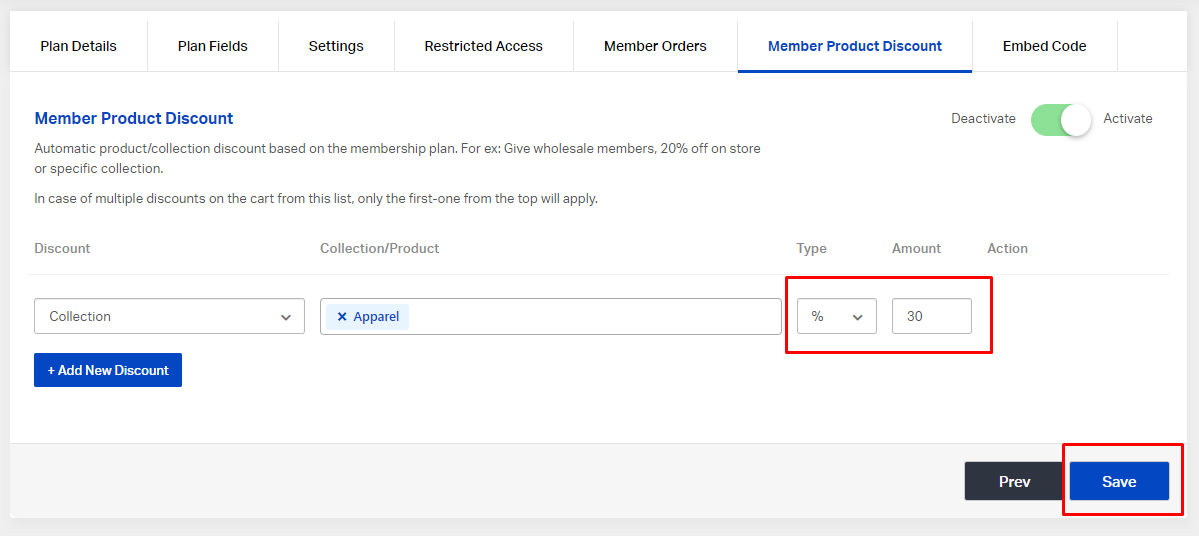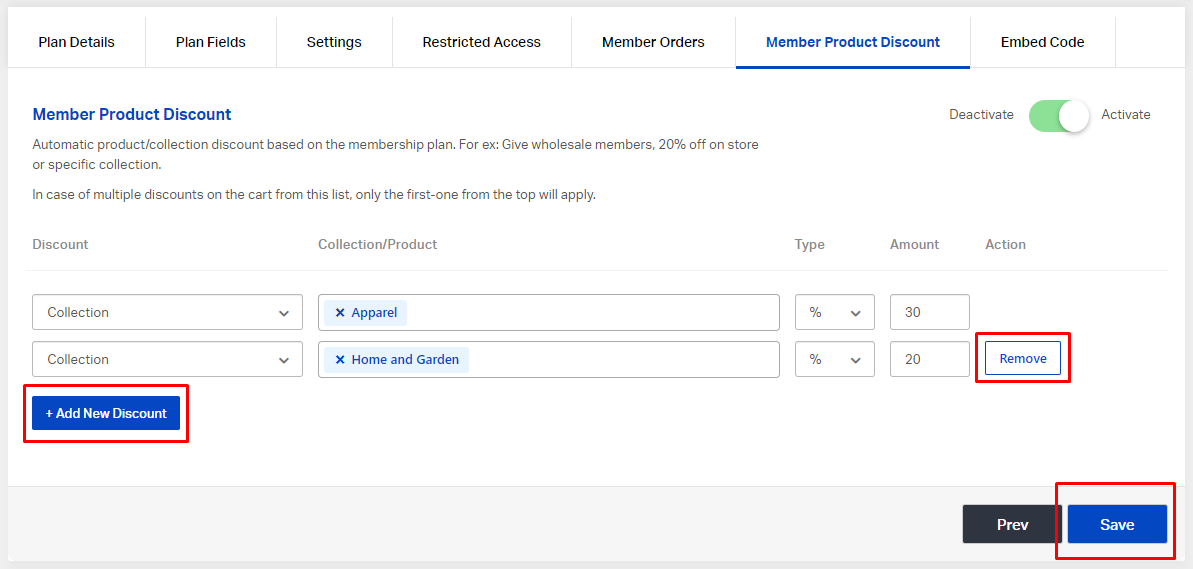Question: How does product & collection discount works based on members plan?
Solution:
An automatic product discount coupon can be created based on some specific collections or products for the current plan subscribers.
Check the quick video to setup the discounts:
Follow the below steps for guidance
Step 1. Go to the Membership Subscription Order app dashboard and create a new free or paid plan if doesn’t exist.
Step 2. Fill in all the required details in other plan tabs available and go to the Member Product Discount tab.
Step 3. Toggle button to activate it.

Step 4. Select Product or Collection from the Discount dropdown.
When you select a collection, it will show the list of collections in the drop-down you have in your store. You can select the collections on which you want to give a discount to the members.

When you select a product, it will show the list of products in the drop-down you have in your store. You can select the products on which you want to give a discount to the members.

Step 5. Select the type of discount percentage or a fixed amount.
Step 6. Enter the discount amount.
Step 7. Click on the Save button to save the discount.

You can create more discount rules by clicking on the Add New Discount button
You can remove any discount rule by clicking on the Remove button

NOTE –
- When any subscribed member purchases a product from the offered collections or products then the member will get an automatic discount on the checkout page.
- For getting the discount, it is mandatory for the subscribed member to visit the store cart page.
FAQ
Q. What happens when I select “All Products” or “All Collections” from the dropdown?

Ans: When you create a discount rule with “All Products” or “All Collections” from the dropdown. Then the discount will be applied to the Subtotal.
Q. What happens when I select a product discount and a collection discount and if the product belongs to that collection also.

Ans: When a plan has both product discounts and collection discounts, and the product belongs to the collection also. Then our app gives priority to the product discount. For example, you have created a rule to give 10% discount on Apparel collection and 30% discount on Classic Leather Jacket and this product belongs to Apparel collection. And if a user purchases Classic Leather Jacket then the user will get a 30% discount as mentioned in the product discount rule.
Q. What happens when I create two different discounts with two collections and customer purchases products from both collections?
 Ans: When a plan has two different discount rules for collections and a customer purchases a product from each collection then the customer will get the discount for both of the products.
Ans: When a plan has two different discount rules for collections and a customer purchases a product from each collection then the customer will get the discount for both of the products.
For example, when you create a 10% discount on the Apparel collection and a 20% discount on the Home and Garden collection. And if a customer adds a product from the Apparel collection into his cart and then the customer adds one more product from the Home and Garden collection. Then the customer will get a 10% discount from the Apparel collection as well as a 20% discount on the Home and Garden collection.
Q. What happens when I select multiple products or collections while creating a discount rule?
 Ans: When you select multiple products or collections then the customer will get a discount on all the products or collections which is specified in the discount rule.
Ans: When you select multiple products or collections then the customer will get a discount on all the products or collections which is specified in the discount rule.
Q. What happens when a customer subscribes to two plans (Plan A and Plan B) Plan A has a collection discount rule, and Plan B has a product discount rule?
Ans: When a customer subscribes to two plans (Plan A and Plan B) Plan A has a collection discount, and Plan B has a product discount. When a customer purchases a product that fulfills both plan rules then the customer will get the product discount. The product discount rule will get priority over the collection discount.
Q. What happens when a product belongs to two collections and the user purchases it?
Ans: When a product belongs to two collections (collection A and collection B) and a discount rule is created for both collections. For example 10% discount on collection A and 20% discount on collection B. When a user purchases that product, the user will get a discount on the collection to which a product was recently added. If a product initially belongs to collection A, and later on it belongs to B also. Then the user will get the discount as per the collection B that is a 20% discount.





